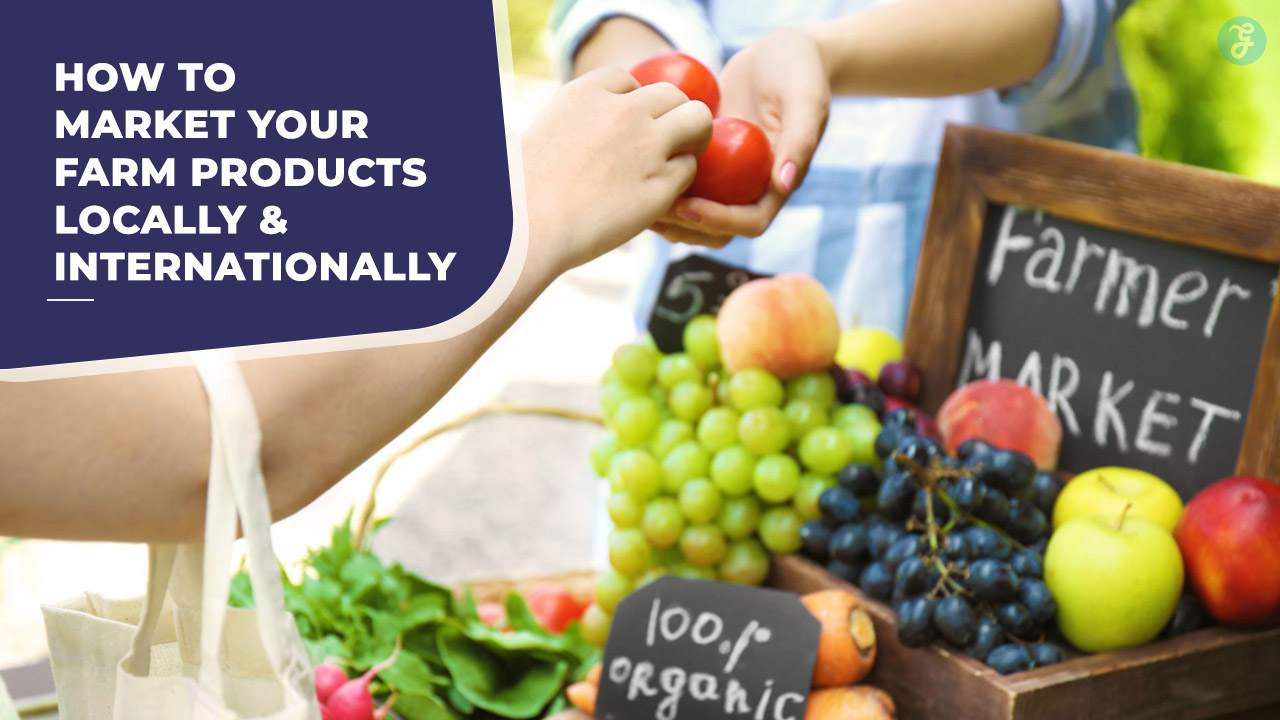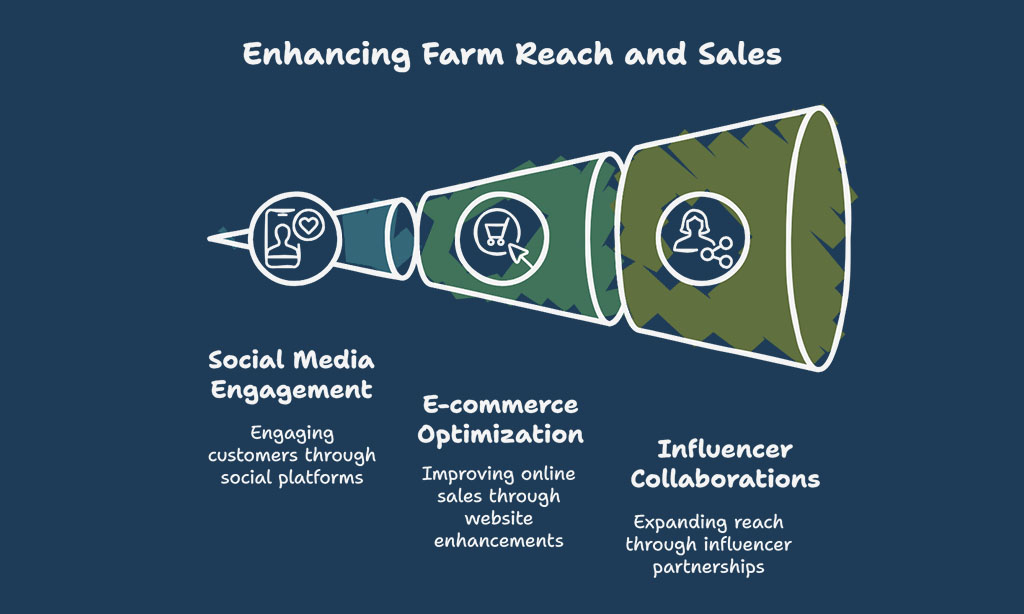Selling farm products can be tricky. Many farmers struggle to find the right buyers or make enough profit, whether selling locally or reaching global markets. This can lead to frustration and lost opportunities.
Demand for fresh produce and organic food is growing everywhere. Local sales help build community ties, while the international market offers higher profits—but both need smart marketing strategies.
This blog will guide you step-by-step on how to sell your farm products effectively. You’ll learn tips for reaching local customers and ideas for entering global markets.
Keep reading—it’s easier than you think!
Building a Strong Farm Brand
A strong farm brand helps your products gain recognition. Use a unique selling proposition (USP) to emphasize what makes your farm unique. For example, focus on organic certification or sustainable farming practices.
Ensure your name and logo are simple, clear, and easy to recall.
“Creating confidence with customers starts with quality.
Share stories about your farm’s development through social media platforms like Twitter or Instagram. Show how you grow fresh produce or follow fair trade practices. Connect with customers by asking for feedback online or during direct-to-consumer sales at farmers’ markets.
Brand loyalty strengthens when people feel involved in the process behind their food.
Local Marketing Strategies
Selling farm products locally brings you closer to your community. Use creative ways to connect with customers and grow trust in your brand.
Farmers’ Markets
Farmers’ markets create direct sales opportunities for small farmers. They help build strong customer relationships and encourage local support.
- Sell fresh produce directly to local customers without involving middlemen. This maximizes profits for small farmers.
- Meet your target audience face-to-face, which builds trust and loyalty for your farm brand.
- Test new agricultural products and gather customer feedback instantly during market days.
- Choose markets with high foot traffic to increase sales and visibility of your farm products.
- Display organic certification at your booth to attract health-conscious buyers.
- Use these events to promote good agricultural practices by educating customers about sustainable farming methods.
- Offer samples of fruits, vegetables, or other farm produce to draw more people into purchasing full items.
- Set up clear signs highlighting your farm name and the benefits of buying local produce.
- Accept multiple payment options including cash, cards, or even online payments through apps to boost convenience for buyers.
- Participate in seasonal farmers’ markets during high-demand times like summer and spring when food trends favor fresh goods.
Community Supported Agriculture (CSA)
Community Supported Agriculture (CSA) connects farmers and local buyers. It helps small farmers sell fresh produce directly to customers while building strong ties with them.
- Offer a subscription service where customers pay upfront for fresh produce. This ensures steady income for the farm and builds customer loyalty.
- Provide a variety of options like weekly or monthly boxes of seasonal fruits, vegetables, or other farm products. Include organic farming certifications if possible to attract health-conscious buyers.
- Promote CSA programs through social media marketing and email marketing campaigns to reach target audiences in your area. Use eye-catching photos of the farm produce to increase interest.
- Partner with local businesses like grocery stores or restaurants that focus on sustainable agriculture to expand your reach.
- Build an online presence with e-commerce websites or use online marketplaces for easier sign-ups and payments from subscribers.
- Collect customer feedback after each season to improve services, maintain trust, and boost customer retention.
- Create farm events for CSA members, such as “pick-your-own” days or workshops about sustainable farming practices, which can deepen buyer engagement.
- Highlight agricultural trends in newsletters or social networking sites to keep subscribers informed about their purchases.
- Reduce transportation costs by aligning deliveries with high-demand areas or setting up shared drop-off points within a community.
- Ensure compliance with food safety regulations like the Food Safety Modernization Act (FSMA) to build trust and meet USDA standards.
Farm-to-Table Partnerships
Farm-to-table partnerships connect farms with local businesses. These links help farmers sell fresh produce directly to consumers while supporting sustainable farming.
- Partner with local restaurants that value fresh, seasonal ingredients. Many chefs prefer farm produce for its quality and taste.
- Work with schools to provide healthy meals. Schools often need fresh fruits, vegetables, and meats from trusted sources.
- Sell directly to grocery stores focusing on organic or local products. Many small farmers gain steady income through these sales.
- Collaborate with catering companies that highlight locally sourced items during events like weddings or conferences. This can boost brand recognition for your farm products.
- Offer exclusive deals to farm-to-table meal services prioritizing community-supported agriculture (CSA). This keeps customers returning for your products.
Hosting Farm Events
Hosting farm events helps bring people to your farm. It boosts sales and builds trust with customers.
- Invite the community to a “Farm Day.” Show how you grow fresh produce and care for animals. Offer free samples of your products. Families love fun activities like corn mazes or tractor rides.
- Teach classes about sustainable farming or organic growing. Share tips on food safety and inspection services from USDA’s guidelines. This shows your expertise and builds customer engagement.
- Organize seasonal festivals, like strawberry picking in summer or pumpkin hunts in fall. These events attract large crowds and promote direct-to-consumer sales.
- Host farm dinners using your own produce. Partner with local chefs or restaurants for a unique farm-to-table experience. This creates strong CSA connections while showcasing the freshness of your products.
- Create workshops for kids to learn about agriculture trends, food security, or cash crops. Parents value educational opportunities tied to healthy eating habits.
- Offer guided tours explaining fair trade certifications, organic agriculture methods, or USDA grading standards like Prime or Choice beef grades.
- Use email marketing to invite past customers to exclusive events before announcing publicly online—a great way to strengthen customer retention.
- Engage local influencers during events to share experiences online through social media platforms like Instagram or Facebook Stories.
- Set up photo zones highlighting your brand name and products displayed beautifully against rustic backdrops—perfect for attracting attention on social media posts later on!
- Collect feedback after each event by offering small discounts as incentives for customer opinions about their visit experience—this improves future marketing strategies effectively!
Online Marketing Strategies
Promote your farm online to reach more buyers. Use digital tools to showcase fresh produce and attract direct consumers.
Social Media Marketing
Social media helps farms reach more customers fast. It is a simple and powerful tool for promoting farm products.
- Use Facebook, Instagram, and Twitter to showcase fresh produce. Post eye-catching photos of your farm and products weekly.
- Share updates about sustainable farming practices. This builds trust with buyers who value eco-friendly methods.
- Run ads targeting local buyers who search for produce online. Highlight special deals or farm events in the posts.
- Create videos showing daily farm life. These make followers feel connected to your work and products.
- Engage with customer feedback on social platforms. Answer questions quickly to build strong relationships with buyers.
- Tag locations in posts for better local reach. This helps people nearby find your farm easily.
- Partner with influencers who focus on organic lifestyle or food trends. They can help promote your produce to wider audiences.
- Add clear links to your e-commerce website in every post or story. Make it easy for followers to buy directly from you online.
- Track user engagement and adjust strategies every month based on what works best.
- Host live sessions to share tips about cooking with seasonal vegetables or fruits you sell. These boost viewer interest in your offerings while keeping them engaged longer!
E-commerce Websites
Selling farm products online can increase sales and reach. An e-commerce website helps farmers connect with more buyers.
- Create a simple, user-friendly website to sell fresh produce directly to customers.
- Highlight unique features like organic certification or sustainable farming practices.
- Use high-quality photos of farm products. Clear pictures attract buyers and build trust.
- Offer easy payment options like credit cards, PayPal, or digital wallets for convenience.
- Share customer reviews and feedback on the site to boost confidence in your products.
- Include clear information about shipping, transportation costs, and delivery times.
- Optimize the site with search engine optimization (SEO) tools to appear in local searches for farm produce.
- List items with detailed descriptions, like USDA certifications or fair trade labels, if applicable.
- Add email marketing pop-ups to collect customer emails for direct-to-consumer sales updates and promotions.
- Track market trends and update product listings based on buyer behavior and demand patterns online.
This creates better access to both local customers and international markets while saving time for small farmers!
Collaborations with Influencers
Working with influencers can help farms reach new audiences. They can promote fresh produce, farm products, and farming practices to their followers.
- Find local or niche influencers who focus on food, sustainability, or agriculture trends. They connect well with your target market and build trust quickly.
- Offer free samples of farm produce for honest reviews. Influencers often share their experience online, creating direct-to-consumer sales opportunities.
- Use social media marketing to team up with influencers on Instagram, Facebook, or TikTok campaigns. These platforms are powerful marketing channels for reaching both local and international audiences.
- Run giveaways or contests with influencers to draw attention to your fresh products. Many people join these events to try organic farmers’ goods.
- Share content created by influencers across your own digital marketing channels like e-commerce websites or email marketing campaigns. This keeps the message consistent while boosting customer engagement.
- Discuss fair trade-certified farming methods or sustainable agriculture techniques with eco-conscious influencers. Many consumers prefer buying from small farmers using organic certification processes.
- Work with influencers who travel internationally and highlight farm-to-table dining experiences abroad. This expands potential market access globally.
- Gather customer feedback through influencer posts and comments to spot consumer preferences in different locations easily.
Strategies for International Markets
Selling farm products abroad can open new doors and boost income. Study market rules carefully, and plan for smooth shipping.
Export Partnerships
Exporting farm products can help you reach global buyers. It increases sales and brings new opportunities for small farmers.
- Partner with international distributors. These companies can help sell your farm products in other countries.
- Connect with the Foreign Agricultural Service (FAS). They support farmers interested in exporting fresh produce globally.
- Study market trends in target countries. Understand what fresh produce is in demand, like USDA Prime or organic certification goods.
- Build relationships with fair trade certified organizations. They ensure ethical practices and open doors to new markets.
- Learn about international regulations. Each country has rules for importing goods, such as organic certifications or food safety laws.
- Reduce transportation costs by choosing reliable shipping companies. This saves money and ensures farm produce stays fresh during delivery.
- Use online marketplaces to find buyers abroad. Platforms like e-commerce websites can connect your products directly to customers worldwide.
- Join agricultural marketing services or export groups. They provide tools, resources, and connections to expand globally.
- Share customer feedback from local buyers with foreign clients. This builds trust and highlights the quality of your items, boosting customer retention.
- Apply for programs through USDA’s National Organic Program or similar agencies if you meet their standards for global selling benefits.
Export partnerships require research but open many doors for small farmers aiming to grow their business beyond local limits!
Understanding International Market Regulations
Farmers must follow export rules and permits before selling farm products internationally. Some countries need organic certification or proof of sustainable farming practices. These steps show product quality and safety to buyers.
Market research is key for understanding consumer behavior in other countries. Rules about food labeling, packaging, or transportation costs can vary by region. Knowing these helps small farmers avoid fines and reach global markets with ease.
Takeaways
Marketing farm products locally and internationally is possible with the right actions. Building a strong brand helps customers trust your goods. Using farmers’ markets, CSAs, and online stores makes local sales easier.
Social media can connect you to new buyers quickly. For global reach, study market rules and form export deals. Start small and steady—the results are worth it!
FAQs
1. How can I create a strong marketing strategy for my farm products?
Start by researching market trends and agricultural trends. Use social media marketing, email campaigns, and content marketing to build your online presence. Focus on customer retention by sharing updates about your fresh produce or sustainable farming practices.
2. What are the best ways to sell farm products locally?
You can sell at farmers’ markets, through community supported agriculture (CSA) programs, or directly to consumers using direct-to-consumer sales methods. These options help reduce reliance on middlemen and lower transportation costs.
3. How do I expand my farm product sales internationally?
Use online marketplaces that cater to global buyers while ensuring organic certification if needed. Study international market research and food security needs in target regions to align with demand.
4. Why is customer feedback important in agriculture marketing?
Customer feedback helps you improve your farm produce quality and adjust your marketing strategies based on what buyers want most—whether it’s better packaging, fresher goods, or more sustainable options.
5. Can small farmers compete with larger producers in the market?
Yes! Small farmers can stand out by emphasizing sustainable agriculture practices, promoting USDA Choice certifications when applicable, and focusing on personalized customer relationships through direct communication channels like CSAs or email lists.
6. How does an online presence benefit local farms?
An online presence boosts visibility for small farms beyond physical locations like farmer’s markets or CSAs. It allows you to share stories about your farming methods while attracting both local and international customers interested in fresh produce from trusted sources like yours!









































